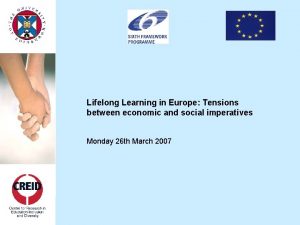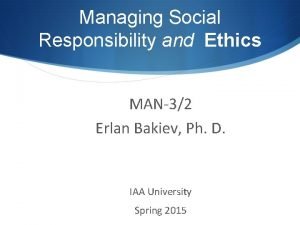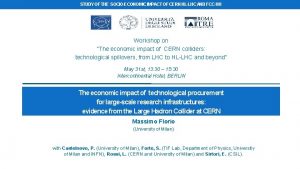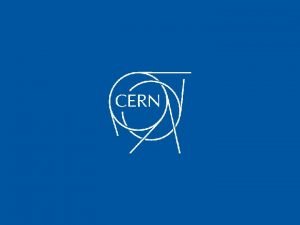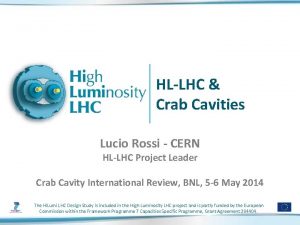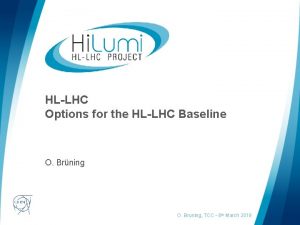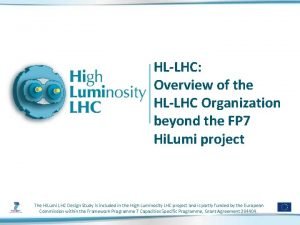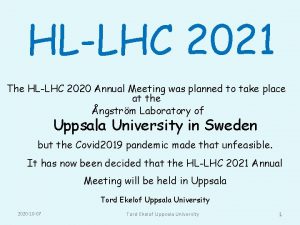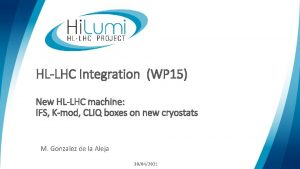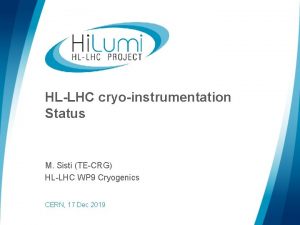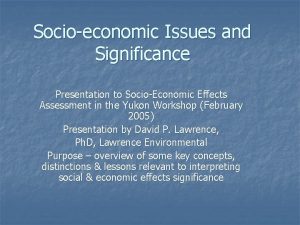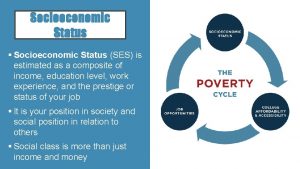STUDY OF THE SOCIOECONOMIC IMPACT OF CERN HLLHC



















- Slides: 19

STUDY OF THE SOCIO-ECONOMIC IMPACT OF CERN HL-LHC AND FCC-HH Workshop on “The economic impact of CERN colliders: technological spillovers, from LHC to HL-LHC and beyond” May 31 st, 13: 30 – 15: 30 Intercontinental Hotel, BERLIN A new survey of CERN suppliers: a Bayesian Network Analysis (BNA) Emanuela Sirtori (CSIL) with Florio, M. (University of Milan), Giffoni F. (Rossi-Doria Centre) and Giunta, A. (Roma Tre University, Rossi-Doria Centre)

2/19 Motivation and Research Hypotheses Does CERN stimulate innovation and economic performance of firms through its procurement activity? In what way? H 1: the technological level and the volume of orders shape the relationship between CERN and its suppliers H 2: more structured types of relationships positively influence CERN suppliers’ innovation outcomes H 3: innovation outcomes of CERN supplier firms are expected to positively impact on their economic performance H 4: innovation spillovers are not only confined to CERN (first-tier) suppliers, but they spread along the supply chain

Conceptual model H 1 H 2 H 3 H 4 3/19

4/19 Survey • To all CERN suppliers which received at least 1 order > 10, 000 CHF between 1995 and 2015 • 5 languages on-line survey • Multiple-choice questions, 5 point Likert scale (strongly disagree, …, strongly agree) Population Sample (as of end April 2017) 4, 204 suppliers from 47 countries 538 (13%) suppliers from 31 countries 33, 414 orders 6, 679 (20%) orders 4, 318 Million CHF of expenditure 732 (17%) Million CHF of expenditure

5/19 Sample (1)

6/19 Sample (2) Volume of orders (CHF) POPULATION Volume of orders (CHF) SAMPLE 10 Thousand 1. 0 Million 1. 3 Million 67 Thousand 118 Thousand Max 237 Million 173 Million SD 7. 6 Million 8. 2 Million Indicator Min Mean Median

7/19 Methodology of analysis Bayesian Network Analysis (BNA): • Conditional probability distributions to find multiple relationships and dependences among variables • Hierarchical arrangement of variables via a directed acyclic graph • Causal mechanisms are revealed • Find unexpected relationships between variables + Econometric analysis to test the robustness of results

8/19 Bayesian Network CHF per order High-Tech Supplier H 1 H 2 Relationship duration Relational Hybrid Experience with… Universities / research institutes Large laboratories Market Nonscience customers Learning outcomes New patents and IPR New services New products Customer outcomes New customers New technologies H 3 Increased Sales Time from the last order Reduced costs Started a new business Established new R&D unit Hybrid second-tier Relational second-tier Increased profitability Entered a new market Second-Tier HT supplier Market second-tier H 4 Geoproximity Increased know-how Innovated products or processes Improved production process Attracted new customers

9/19 Testing H 1: CERN-supplier relationship H 1: the technological level and the volume of orders shape the relationship between CERN and its suppliers HYBRID MARKET RELATIONAL

10/19 Testing H 1: CERN-supplier relationship Experience with… High-Tech Supplier CHF per order Other large laboratories Universities / research instit. Non-science customers Hybrid Relational Relationship MARK ETduration Market: full autonomy and little interaction with CERN staff Hybrid: additional inputs (clarifications, cooperation on some activities) from CERN staff Relational: frequent and intense interactions with CERN staff

Testing H 2: innovation outcomes H 2: more structured types of relationships positively influence CERN suppliers’ innovation outcomes 11/19

12/19 Testing H 2: innovation outcomes (cont. )

13/19 Testing H 2: innovation outcomes (cont. ) Hybrid Relational Market Relationship duration Time from last order Learning outcomes New patents and IPR New services New products New technologies Customer outcomes New customers

Testing H 3: economic performance 14/19 H 3: innovation outcomes in CERN supplier firms are expected to positively impact on their economic performance

Testing H 3: economic performance 15/19 H 3: innovation outcomes in CERN supplier firms are expected to positively impact on their economic performance

16/19 Testing H 3: economic performance (cont. ) Learning outcomes New patents and IPR New services Customer outcomes New products New technologies Increased Sales Established new R&D unit New customers Reduced costs Started a new business Increased profitability Entered a new market

Testing H 4: spillovers to value chain 17/19 H 4: innovation spillovers are not only confined to CERN (first-tier) suppliers, but they spread along the supply chain (339) (199)

18/19 Testing H 4: spillovers to value chain (cont. ) Hybrid (first-tier) Hybrid (second-tier) Relational (first-tier) Market (first-tier) Second-Tier HT supplier Relational (second-tier) Market (second-tier) Geoproximity Increased know-how Innovated products or processes Improved production process Attracted new customers Potential innovation outcomes as perceived by CERN suppliers

19/19 Conclusions • This study provides empirical evidence about the various types of benefits accruing to companies involved in a procurement relationship with CERN: o o o • Technological benefits Learning benefits Market benefits Economic performance Key mechanisms which explain the type and size of benefits enjoyed are: o o The way how CERN interacts with its suppliers The type and volume of orders
 Socioeconomic model
Socioeconomic model Socioeconomic examples
Socioeconomic examples Whats socioeconomic status
Whats socioeconomic status Socioeconomic view
Socioeconomic view Nace impact study
Nace impact study Nace impact study
Nace impact study Hát kết hợp bộ gõ cơ thể
Hát kết hợp bộ gõ cơ thể Ng-html
Ng-html Bổ thể
Bổ thể Tỉ lệ cơ thể trẻ em
Tỉ lệ cơ thể trẻ em Chó sói
Chó sói Tư thế worms-breton
Tư thế worms-breton Hát lên người ơi
Hát lên người ơi Môn thể thao bắt đầu bằng chữ f
Môn thể thao bắt đầu bằng chữ f Thế nào là hệ số cao nhất
Thế nào là hệ số cao nhất Các châu lục và đại dương trên thế giới
Các châu lục và đại dương trên thế giới Công thức tiính động năng
Công thức tiính động năng Trời xanh đây là của chúng ta thể thơ
Trời xanh đây là của chúng ta thể thơ Cách giải mật thư tọa độ
Cách giải mật thư tọa độ Làm thế nào để 102-1=99
Làm thế nào để 102-1=99
